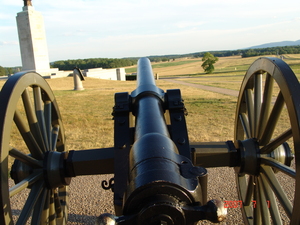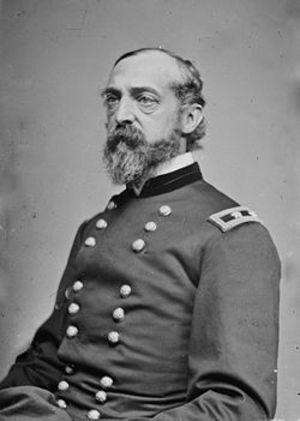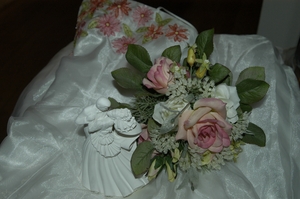Civil War cannons were divided into two classifications: the smoothbore and the rifle. The smoothbore lacked accuracy and range of fire, whereas the rifle cannon were more accurate and had greater range.
Smoothbore cannons were very good in firing canister rounds, which were tin cans filled with iron balls, something like a shotgun effect. When fired, the iron balls would spread out in a wide pattern, thus making it very effective against an attacking infantry force.
The rifled cannons had the advantage of firing long range with greater accuracy. These rifled cannons were great against opposing artillery and infantry.
The basic unit of the artillery was the battery. The size of a battery was different in the opposing armies, in the Northern Army a battery generally contained four to six field pieces and was manned by 80 to 100 soldiers.[1] The Confederate Army usually had four cannons per battery. A battery usually needed around 110 horses and was commanded by a Captain, four lieutenants and eight sergeants.
There are five basic “guns”, the Six Pounder, range 1520 yards, Light 12-Pounder, range 1620 yards, 10-Pound Parrott, range 2000 yards, 20-Pounder, range 2100 yards and the 3-Inch Ordnance Rife, range 1850 yards. The Howitzers are shorter-barreled cannons designed to fire projectiles with a nearly flat trajectory. They take a smaller charge and have a shorter range. Three types of howitzers are: 12-Pounder, range 1100, 24-Pounder, range 1325 and the Mountain Howitzer, 900 yards.[2]
The types of ammo used were Solid Shot, for smoothbore cannon the cast-iron solid shot is a spherical cannonball and for the Rifled cannon it is an elongated projectile called a bolt. Next is the Shell is a hollow iron projectile filled with a bursting charge of black powder. The Case Shot also called shrapnel shell was designed to explode in the air; the Canister was a simple tinned-iron can full of iron or lead balls packed in sawdust. It was designed to act like a giant shot-gun blast. It was deadly for charging infantry at short range. Grape Shot was similar to a canister, but had fewer and larger balls, held together with iron rings or trussed up with fabric and twine.[3]
In battle an artillery battery on line covered 82 yards, with 14-17 yards between guns, and a nine man crew per piece. One the march, batteries travel in single file covering two-and-one-half miles per hour. At a rapid march, five miles-per-hour could be attained, but only for short distances. Under excellent conditions a battery pulled by its 90+horses might move 35-40 miles per day.[4]
On the first day of the Battle of Gettysburg the Union artillery did much to help hold back the Confederates until they were flanked and forced to retreat. Capt John Calef, Battery A, 2 US and Capt James Hall, Battery B, 2nd ME was the first on the field and opened by battle for the artillery. Capt James Cooper, Battery B, 1st PA, Capt Gilbert Reynolds, Battery L, 1st NY and Capt Greenleaf Stevens, Battery E, 5th ME fought all day and made the final stand at the Lutheran Theological Seminary. The above mentioned batteries lost a total of 83 officers and men killed and wounded and 80 horses killed.[5] The 11th Corps Artillery also suffered heavy losses, 69 officers and men killed, wounded and missing and 98 horses killed. Lt Bayard Wilkerson, Battery G, 4th US was killed, Capt Dilger, Battery I, 1st OH and Capt Lewis Heckman, Battery K, 1st OH did excellent work until forced to retreat to Cemetery Hill.
The artillery brigade of the 2nd Corps saw heavy action on July 2nd and 3rd. Lt Alonzo H. Cushing, Battery A, 4thUS was killed on July 3rd during Pickett’s Charge. Lt George Woodruff, Battery I, 1st US was mortally wounded during Pickett’s Charge and died the next day. Capt James Smith, 3rd Corps, 4th NY seen action against the 1st Texas and 15th Georgia at Devil’s Den losing three of his guns. Capt George Winslow, Battery D, 1st NY held back the advancing Confederates at the Wheatfield until forced to retire. At the Peach Orchard, Capt Judson Clark, Battery B, 1st NJ and Lt John Bucklyn, Battery E, 1st RI fought hard when the infantry retreated.
Lt Charles Hazlett, Battery d, 5th US, 5th Corps died on Little Round Top. His battery was taken over by Lt Benjamin Rittenhouse who on July 3rd did heavy damage to the men of Pickett’s Charge. Capt Andrew Cowan, 1st NY, 6th Corps lost four enlisted men killed, one mortally wounded, two lieutenants and six men wounded. Part of three 12th Corps batteries was deployed on the crest of Culp’s Hill. They provided timely firing against the confederate batteries on Benner’s Hill. On the early morning of July 3rd, Lt Kinzie, Battery K, 5th US and Lt Sylvanus Rugg, Battery F, 4th US opened fire on the confederates that were inside the Union’s entrenchments.
Lt Col McGilvery’s Artillery Brigade which was part of the Artillery Reserve was ordered to support Gen Sickles’ line on July 2nd. His brigade consisted of Capt John Bigelow, 9th MA, Capt Charles Phillips, 5th MA, Capt Patrick Hart, 15th NY and Capt James Thompson (C&F;), 1st PA. Because of LtCol McGilvery’s outstanding leadership and timely movement of the artillery under his command, he was able to slow down the attack of Barksdale Mississippian’s and insure that the Union’s line of Cemetery Ridge would hold.
East Cemetery Hill saw heavy artillery action on the night of July 2nd. The hill was put under attack by Gen Johnson’s Division of Ewell Corps. Lt George Norton, Battery H, 1st OH, Capt Frederick Edgell, Battery A, 1st NH and Capt Wallace Hill, Battery C, 1st WV were located in the Evergreen Cemetery facing North and West. Capt Elijah Taft had four guns along the Baltimore Pike side and to on the crest facing north toward the town. Capt Robert Rickett’s (F&G;, 1st PA) battery replaced Capt James Cooper, Battery B, 1st PA on East Cemetery Hill. Members of Avery’s and Hays’ brigades got among Rickett’s guns and only the brave members of the battery and timely arrival of reinforcements saved the guns. Steven’s Battery e, 5th ME also help repulse the attack on East Cemetery Hill, by providing flank fire causing the confederates to push to the right and come under fire from the artillery on East Cemetery Hill.
As stated by Gregory A. Coco in his book “A Concise Guide to the Artillery atGettysburg“ “During the Battle of Gettysburg well over 55,000 artillery projectiles were fired by both armies. Generally each cannon crew had available 200 rounds of ammunition present for its piece. Another 250 rounds per gun were required to be present in the ordnance supply wagons accompanying the army. These vehicles had a red six-inch horizontal stripe painted on the canvas covers, as well as the division and corps number it belonged to.” Artillery played a very important role in the outcome of the battle, and overall the commanders of artillery did a good job.
It took a brave and dedicated soldier to charge into the mouth of cannons loaded with canister, sometimes double or triple canister. For all who manned the guns, for all who died at their guns, we have an obligation to honor their memory and what they did. We can do that by helping to preserve the ground that they fought and shed their blood on.
[1] Artillery Tactics of the Civil War by R.L. Murray
[2] www.cwartillery.org/aguns.html
[3] www.cwartillery.org/artammo.html
[4] A concise guide to the Artillery at Gettysburg by Gregory A. Coco
[5] A Concise Guide to the Artillery at Gettysburg by Gregory A. Coco



